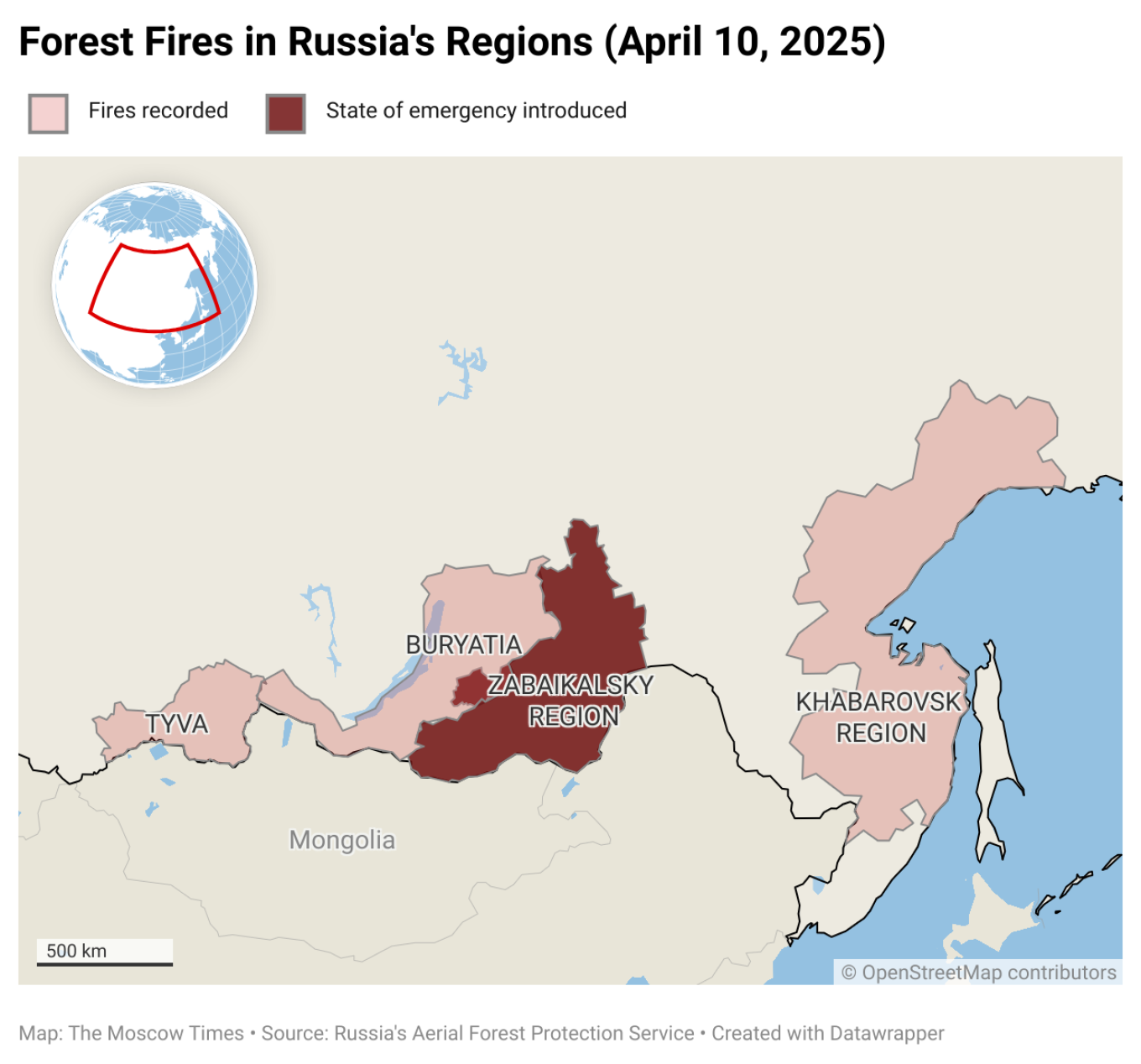
Forest fires have swept several of Russias Siberian and Far East regions over the past week, setting off what is projected to be yet another devastating wildfire season.At least 52 wildfires spanning more than 41,675 hectares were active across Russia on Thursday, the country's Aerial Forest Protection Service reported.Authorities have already declared the start of the wildfire season across 64 regions of Russia, as well as the occupied Ukrainian regions of Donetsk, Luhansk and the annexed Crimean city of Sevastopol.Though most wildfires in Russia are caused by human activity especially the widespread practice of burning dry grass in the hope of reducing the effects of wildfires on inhabited areas snow drought and the unusually early arrival of spring this year further increase the risk of widespread forest fires, experts say.The majority of the blazes recorded in Russia at least 31,903 hectares were in the Far East Zabaikalsky region, where authorities declared a region-wide state of emergency on Monday.On Tuesday, fires crept near the regions segment of the Baikal Highway, one of the countrys key routes, forcing authorities to limit the traffic movement, while the regions capital Chita was covered in smog from nearby fires.The Zabaikalsky regions Chief Forest Inspector Valery Shreider said Wednesday that the region doesnt have enough manpower or resources to contain the fires, noting that the help of firefighters from other Russian regions is crucial for bringing the situation under control.Together with the republic of Buryatia and the Jewish autonomous district, the Zabaikalsky region is a countrywide leader in using the controlled burning technique for forest management and fire suppression.Controlled burning involves setting dead grass, trees and thick undergrowth on fire during the least hazardous season to prevent inflammation in the hot and dry summer months.
Each year, Russian federal authorities allocate a significant portion of the budget to carry out the practice.In theory, controlled burning can only be carried out under certain, rather strict conditionsIn practice, there is not enough manpower and resources to carry out controlled burning on large areas while observing all the necessary safety measures, forestry expert Alexei Yaroshenko explained in a post for the Zemlya Kasaetsa Kazhdogo environmental project.Zabaikalsky region Governor Alexander Osipov said that the percentage of the regions land covered by forests has been reduced by 30% over the past 30 years due to regular fires.
More than 70% of these blazes were the result of human-made fires.In nearby Siberia, a powerful windstorm that swept the regions of Kemerovo, Krasnoyarsk and Irkutsk, as well as the republic of Khakassia, last week left several hundred thousand households without electricity and intensified already existing forest fires.At least 17 houses and one school were destroyed in the Irkutsk region when the fires reached settlements across several districts on Saturday.In the republic of Buryatia, authorities introduced a local state of emergency in the Yeravninsky district bordering the Zabaikalsky region.
More than 3,400 hectares of forest were ablaze in Buryatia as of Thursday.Experts predict that the destruction brought by the 2025 wildfire season in Russia could surpass the devastating three-year record of 13.8 million hectares set last year.While April is likely to be marked by most instances of forest fires affecting houses and infrastructure, July and August will likely bring toxic wildfire smog to major Russian cities, according to Zemlya Kasaetsa Kazhdogo.Experts agree that Russian authorities like in previous years remain ill-prepared for the 2025 wildfire season.Alexei Zaretsky / TASSThe Russian government allocated more than 19.9 billion rubles ($234 million) to forest fire protection in 2025.
Though the figure amounts to a nominal increase of funding by 40% compared to last year, the amount of money spent on fire protection did not increase significantly between 2022 and 2024 despite worsening fires and 16% inflation, according to investigative news outlet The Insider.Meanwhile, Russias emergencies ministry continues to experience a shortage of firefighting equipment and, most importantly, manpower.In February, the ministry reported a 15% shortage of staff in the State Fire Management department caused primarily by low salaries in the sector.
This means that in some Russian regions, one fire management specialist is responsible for overseeing an area as large as 60,000 hectares.The problem has been further exacerbated by Russias invasion of Ukraine, which both drove up Russias defense spending at the expense of other areas of the budget and sparked a large outflow of able-bodied men from regions most affected by wildfires to the front lines.During long periods of dry and abnormally hot weather, most regions will not have the capacity and resources to effectively fight the fires, which will likely lead to large-scale emergencies at the regional and interregional levels, wrote forestry expert Yaroshenko.

 8
8






